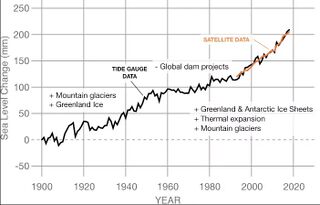Sea level rise
Between 1901 and 2018, the average global sea level rose by 15–25 cm (6–10 in), or 1–2 mm per year.[1] This rate is increasing; sea levels are now rising at a rate of 3.7 mm (0.146 inches) per year.[2] Human-caused climate change is predominantly the cause, as it constantly heats (and thus expands) the ocean and melts land-based ice sheets and glaciers.[3] Between 1993 and 2018, thermal expansion of water contributed 42% to sea level rise (SLR); melting of temperate glaciers contributed 21%; Greenland contributed 15%; and Antarctica contributed 8%.[4] Because sea level rise lags changes in Earth temperature, it will continue to accelerate between now and 2050 purely in response to already-occurring warming;[5] whether it continues to accelerate after that depends on human greenhouse gas emissions. If global warming is limited to 1.5 °C (2.7 °F), then sea level rise does not accelerate, but it would still amount to 2–3 m (7–10 ft) over the next 2000 years, while 19–22 metres (62–72 ft) would occur if the warming peaks at 5 °C (9.0 °F).[2]
References
- ↑ IPCC Report (2019) Summary for Policymakers
- ↑ 2.0 2.1 IPCC Report (2021) Climate Change 2021: The Physical Science Basis
- ↑ Matthias Mengel, Anders Levermann, Katja Frieler, Alexander Robinson, Ben Marzeion, and Ricarda Winkelmann (2016) Future sea level rise constrained by observations and long-term commitment Proceedings of the National Academy of Sciences
- ↑ WCRP Global Sea Level Budget Group (2018) Global sea-level budget 1993–present Earth System Science Data
- ↑ National Research Council (2011) Climate Stabilization Targets: Emissions, Concentrations, and Impacts over Decades to Millennia National Academies Press
